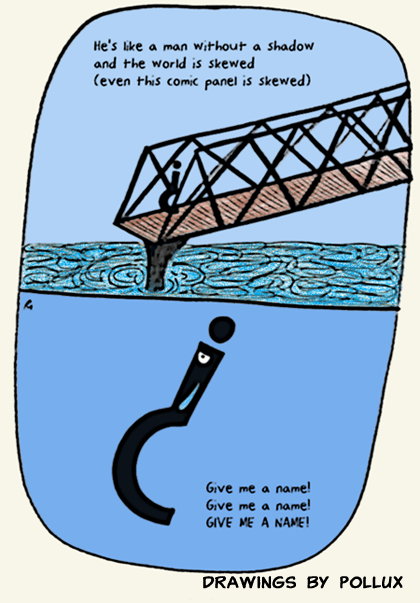


Above: A haunting dramatization of the dilemma in question. Click to enlarge.
The other day, Pollux, our “Wavy Rule” staff cartoonist, and I were questioning some punctuation: namely, the upside-down, Spanish-style question mark. After consulting friend and lettering expert Paul Shaw–who reports that “Bringhurst just calls it an inverted question mark, no special name”–we decided it was a real scandal that this character dare not speak its name. (Parenthetically, I wonder when the nameless mark will become a standard part of the computer keyboard, especially in America, where Spanish is rápidamente becoming our dual language?) So we decided to sponsor a contest. Paul wrote everything from here on–and, of course, drew the searing cartoon above.
You’ve seen it before. It stands on the west end of elegant Castilian questions: ¿Adónde vas? ¿Cuando llegarás? ¿Quien eres tú?
Ah, the upside-down question mark! Its limited range lends this punctuation mark a certain romantic air, its elegant curve bent and shaped by the same winds that propelled caravels and galleons on treasure runs across the ocean sea, its use first legislated in 1754 by a second edition of the volume OrtografÃa, issued by Spain’s Royal Academy.
You can make one yourself: hold your Alt key down, hit the number-lock key, and then type the numbers “168.” [On a Mac, just type option + shift + ?. –Ed.] There, you see it? It stands nobly, and a little sadly, on your computer screen–like a single tear on the face of a father who’s walking his daughter down the aisle of a church, or like a grandee who has been reduced to complete penury but who still points to his ancient coat of arms on the wall.
A noble punctuation mark, to be sure, but deficient in one regard: it lacks a name. “Upside-down question mark” is purely descriptive. Its Spanish name is equally lacking in punch: “signo de apertura de interrogación invertido.”
Now’s your chance to make history. Name this punctuation mark. Give it a name both euphonious and appropriate. Earn everlasting glory. Win a prize–dinner for two at the Spanish, Mexican, Ecuadorian, Dominican, &c., restaurant of your choice, or, if you prefer, a beautiful copy of Pablo Neruda’s immortal The Book of Questions. Emdashes wants to hear your best ideas, so post them in the comments or, if you’re shy (as so many of you are, we know and sympathize), just email us. All entries are due by August 25, no question about it. We are very much looking forward to your submissions. At TypeCon last week, I got two impressive entries from genuine maniac typophiles; I’ll post them in the comments as soon as things get rolling. The very best of luck to you, and andale!
And if you’d like to see more drawings by Pollux, check out “The Wavy Rule” archive.
Emdashes
Modern times between the lines
